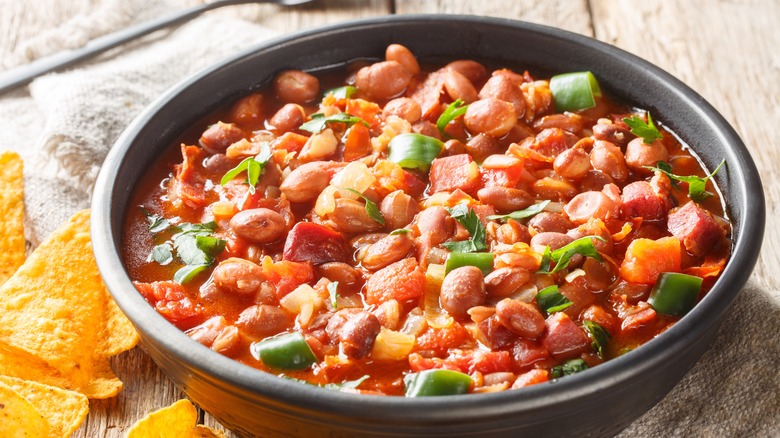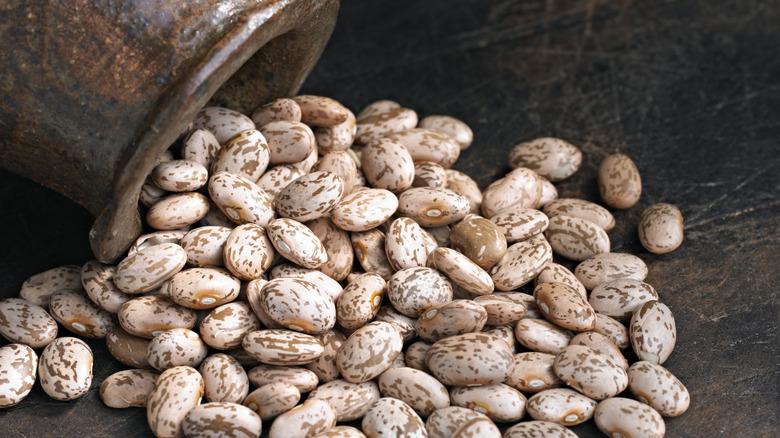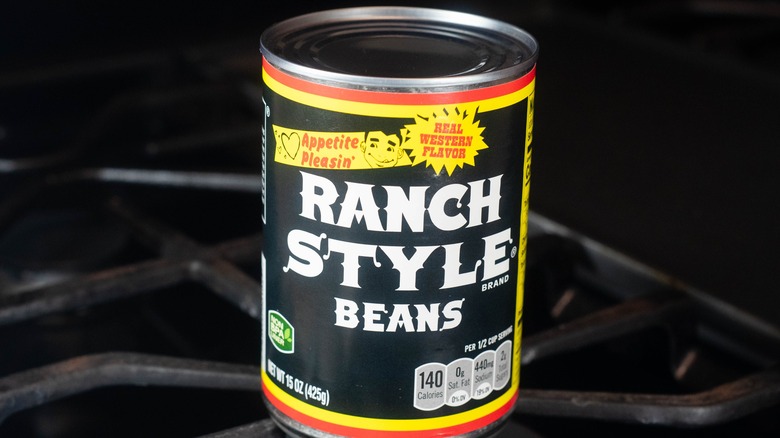The Subtle Difference Between Pinto Beans And Ranch Style
Most everyone knows pinto beans, those tan-hued softies with colorful speckles of reds, yellows, or browns. The name itself accentuates the impact of these mellow beans, with the Spanish word "pinto" translating into English as "painted." But when mentioning ranch-style beans, a spunkier rendition of the creamy pinto bean, a vacant look or furrowed brow often appears on the face of an uninitiated bean-lover. That's unless you hail from Texas, Southwest America, or Mexico, where spicy ranch beans reportedly had their debut in the late 1800s.
The difference between plain pinto beans and their spunky offspring, ranch-style beans, lies primarily in how each is prepared. After all, they're the exact same bean — just accentuated in the ranch version by the addition of perky seasonings, pungent alliums, tomatoes, and other ingredients. Often served in chili-style gravy, they accompany main dishes like grilled meats, barbecue chicken, or smoked brisket. They're also a hearty filler when refried, mashed, or tucked into tacos or burritos. However, many ranch-style devotees don't hesitate to just dish up a big bowl of tender spicy beans and call it dinner.
There's a lot to love about both renditions of these hearty, warm, protein-packing wonder beans. Here's a look at each one separately, in all their edible glory.
Pinto beans get plenty of love on their own
There are no genuine ranch-style beans without their mother source, the pinto bean. Fortunately, that painted legume stands quite well on its merit. Among America's top five dried beans based on per-capita use, the pinto variety takes the number one spot, followed by navy beans, great Northerns, red kidneys, and black beans. Though pinto beans lose their mottled hues when cooked, turning a warm light-brown or pale pink color, the earthy flavor only gets deeper.
Nutrients abound in pinto beans, regardless of how they're prepared or consumed. In addition to the sizeable protein presence, with a mere one-cup serving of cooked pinto beans providing 15 grams of protein, they're a valuable source of fiber, vitamins, minerals, and antioxidants. Pintos are even considered a potential tool for improving heart health and controlling blood sugar.
Besides all that, pinto beans are just plain tasty. Chefs who cook with pinto beans know that they shine in their simplicity. Unfortunately, they're widely known in pre-cooked canned versions that fail miserably at doing them justice. When purchased in dried form, pinto beans come alive as simple pot-cooked beans or in creamy broths and soups, either on their own or accompanied in the pot by flavorful meats, alliums, grains, and tomatoes. You can spice them up with perky chili peppers and aromatic cilantro or oregano. Countless pinto bean recipes stretch the boundaries of this humble legume.
Spunk up your own version of ranch-style beans
Like basic unseasoned pinto beans, ranch-style beans come in canned supermarket versions. Some can be quite good, especially when used as a mixer in other stewy dishes such as a pot of classic chili. But there's no need to hide their goodness, as ranch-style beans have become a classic in their zippy, zesty way. It's easy to ditch the canned version and make ranch-style beans straight from the source. Just buy a bag of dried pinto beans and get cooking.
There's not a single hard-to-find ingredient in most ranch-style bean recipes. You'll need the dried pinto beans, pre-soaked unless using a slow cooker, and a can of tomato paste, crushed tomatoes, or both, plus a touch of brown sugar to counterbalance the potency of the spice parade. Onions and garlic lead the way, followed by a marching band of smoked paprika and the "three c's" of Southwestern and Mexican cooking: cumin, cayenne, and chili powder. From there, you can tweak any recipe with your own creative input, adding chicken broth if desired for thinner consistency, or sizzling things up with some hot sauce or ancho chilis.
When spooned over cooked rice and topped with diced jalapeños, onions, sour cream, and shredded Mexican cheese, you'll hardly miss the presence of meat or meat alternatives. But you can certainly toss some in per preference — it's your own personal ranch-style beans at this point.


